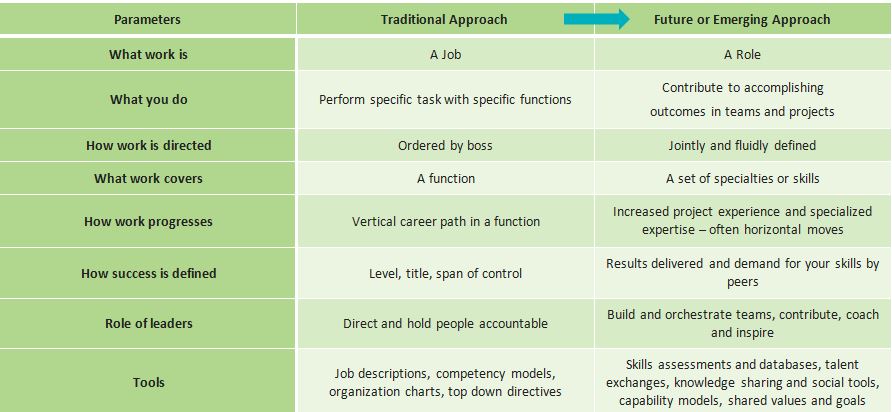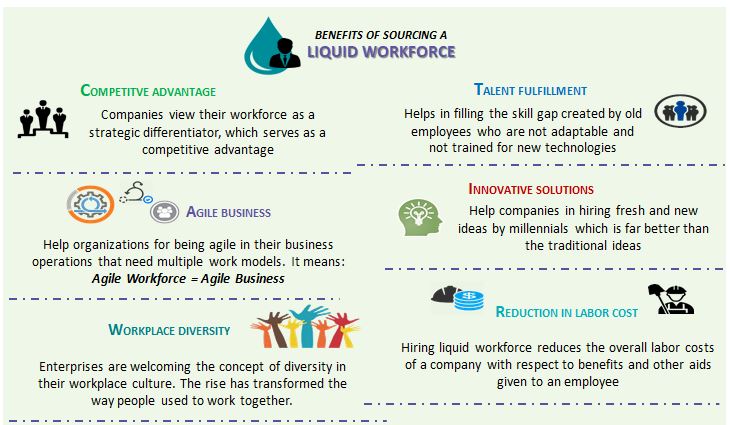
Capitalizing on liquid workforce helps to stay in sync with changing trends

Abstract:
The digital technology has impacted the entire gamut of businesses around the world. Corporates are looking at digital innovation as enablers to transform their workforce, projects and entire organizational structure into a highly adaptable and change-ready enterprise, and not as disruptors. The main backbone of any organization is workforce who should be easily adaptable and change according to the demanding needs of the market. This type of workforce is referred as ‘Liquid Workforce’. To enable smooth transition between people and technology, workforce needs to be re-trained to sustain survival. With the digital economy constituting 22 percent of world’s economy, companies have to embrace technologies at the earliest.
The Liquid Workforce is the future of work across organizations and industries. It is very important for organizations to be forward-thinking and maintain a competitive advantage in a market that requires constant innovation to stay successful. The trend is here to stay and by 2020, it has been observed and analyzed that more than half of the entire workforce will convert to Liquid Workforce. The future is automated and human jobs will be drastically reduced in order to survive in this competitive environment.
Challenges faced by global organizations with respect to workforce and workplace: (Problem Statement)
Baby boomers are declining year by year and companies are facing few challenges with respect to workforce and workplace. Global companies have been facing differences due to proper skill set matching job roles, labor shortages, and implications of Visa restrictions on immigrants by countries such as the U.S., UK, Singapore and Australia. Moreover, two major observations have been made which are: huge gap between demand and supply of labor in the staffing market globally (witnessed in multiple countries) across industries and a constructive disruption of technology in the HR services industry.
How are companies dealing with the challenges: (Solution/Result)
With the rise of millennials in the global economy, organizations call for people with highly agile skillsets, known as liquid workforce or freelancers. This type of workforce helps to overcome the constant changing needs of the market. However, we should know how Liquid Workforce is defined by organizations and industry experts.
Definition of Liquid Workforce:
- The way organizations perform and source work is changing fundamentally and will later require in all industries to rapidly adapt to the emerging trends. However, these will shift the workforce definition from traditional long-term, fixed contractual models towards more evolving and dynamic so-called gig economy millennials that generally builds on crowdsourced workforce models.
- This type of workforce increases flexibility for both employer and employee to adapt to the constantly changing requirement of our modern environment. These changes will lead companies to fundamentally rethink their strategy and approach towards workforce and the model they source workers on a global scale. This type of diverse, flexible and transformative workforce is referred to as Liquid Workforce. This allows the organizations to rapidly adapt, learn and lead the coming changes enabled by highly flexible training and learning system.
Implementation of Liquid Workforce:
Leading enterprises are reshaping themselves to rapidly adapt to any disruption. To drive this change, they need to become agile at each level of their business operations: skills (people), projects and organizations. Therefore, global organizations are developing and investing in tools and technology which helps them to implement Liquid Workforce in their workplace as change is very fast and dynamic across industries and regions.
With this growing trend in automation, industries have started to indulge themselves in supporting cloud-based platforms to offer skills required for automated jobs. Industries such as Information Technology, Insurance, Financial and Banking services, and HR Consulting services, Manufacturing and Retail, Research, and Pharmaceutical have been severely affected by this trend. This shift has imposed global organizations to partner, invest and develop in tools with technology-based platforms to enable agility with modern and diverse workforce especially freelancers.
Companies such as GE, Accenture, Adobe, LinkedIn, Walgreens, WeWork and NAVCO have partnered or developed tech-savvy platforms to integrate workforce agility.
Buyers’ perspective through case studies:
- Accenture: The Company is in a transition phase for transforming its regular employees into a liquid workforce with strength of 373,000 employees. Accenture have 4,000 pieces of automation which they use for transactional activities, this way they have reduced 10,000 roles without reducing any employees. They have trained and re-trained the affected employees in analytics and other emerging skills. This has resulted in integration of workplace strategy and innovation while transforming the careers of people. The company has invested $841 million to develop the people and train through Accenture Connected Learning. This learning initiative includes virtual campus with classrooms, 800+digital learning boards and thousands of online courses.
Another enabler which helps in this transformation is Careers Marketplace, a digital jobs platform providing employees with transparent opportunities based on skills and passions. This way the company is able to retain high value people and train them according to their skill sets.
As a result, employer (company) and employee are becoming agile. In this way, the future of work will unfold and within 10 years, there will be a “fully liquid enterprise” with no full time employees. Moreover, Accenture has partnered with WorkMarket to automate workforce from end-to-end and provide more agile solutions and vendors that can scale virtually on-demand.
- Adobe: Enterprises are taking an active approach in making continual training a core competency. Apart from workforce, enterprises are developing their new defined approach to projects. Adobe has started the initiative with a program called Kickbox, where employees can volunteer to receive red box with a creative tool and $1,000 pre-paid credit card to fund any project which interests them.
With the help of Kickbox, Adobe has distributed 1,200 boxes in last two years. Other companies have started to build a similar approach by collaborating tools and cloud-based workforce allowing anytime, anywhere working culture. They understand that successful projects require different combinations of internal employees, freelancers, and technology for each new challenge.
- GE: New initiative called as FastWorks is embedding lean startup practices into workforce, pushing it to change faster and make smart decisions. It helps in moving away from rigid processes, to allow employees to make rapid changes to their projects and quickly switch direction.
Suppliers Perspective through tools/websites developed to device liquid workforce solution:
- LinkedIn: developed a tool called ProFinder for freelancers which consist of 50,000 freelancers approved by LinkedIn under 140 service categories.
- WeWork: One of the most popular providers of workspace for independent contractors and has expanded to major cities around the world. The company has raised the bar in part by focusing on creating a collaborative ambience where people find at any cutting-edge startup. WeWork spaces even boast arcades, fresh fruit, and beer on tap. More than 150 WeWork partners offer services such as human resources management, web consulting, and accounting help—removing some of the onus on freelancers to do everything themselves. Co-working spaces are providing more than just a sense of community that comes from working around others.
- Upwork: It is the world’s largest freelancing website. Freelancers can offer more than 3,500 skills to buyers. It is simple, quick and cost effective to find and hire freelancers. Buyers such as Chess.com, ZenDesk Support, and Pixc have experienced good response from freelancers active on Upwork.com. Tango, one of their clients, saved 70 percent on customer support costs, improved FRT by 67 percent while serving 350 million users. The website has helped numerous buyers to achieve liquid workforce in their organization and easily available freelancers in the country.
There are numerous tools and websites offering freelancers and independent contractors support to global and mid-small sized companies. Service providers such as Freelancer.com, Guru.com, SimplyHired, iFreelancer, Peopleperhour, etc. have been providing support and helping companies to complete positions with advanced skill sets.
Buyers and suppliers have different perspective with respect to adoption and implementation of the liquid workforce. In the current scenario, the mindset is towards changing the static workforce into liquid/millennial workforce. By 2020, the mindset will be completely changed and will result in 45 percent of the global employees becoming a liquid workforce. As a result, this category of employees will be the most preferred and an adoptable trend by all the companies across regions and industries.
Transition in Workforce Approach:
Source: Supplier Interaction, Beroe Analysis
Advantages enterprises achieve in sourcing a Liquid Workforce:
Liquid Workforce has been coined by different names by different people. Industries are experiencing digital disruption where business goals are changing regularly, where organizations must reinvent themselves to be ahead of others in the market. This change and shift towards liquid workforce provides numerous benefits to organizations.
Risk Mitigation: (Conclusion)
By 2020, millennials or liquid workforce will make up over a third of the global workforce. Employers need to take a fresh look at their people strategies and workplace development. Liquid workers are shaping and being shaped by the world of work. They are redefining the employee-employer relationship. Freelancers, contract workers, vendors, full-time employees, and part-time employees are beginning to work together in agile ‘labor clouds’ that deliver serious results.
While enterprises have encouraged the concept of Liquid Workforce across industries and domains, automation is also taking place replacing humans. Several jobs are now at risk with the scope of automation expanding. In practice, automation depends on several factors such as technical feasibility, costs to automate, relative scarcity, skills and cost of workers, benefits of automation beyond labor-cost substitution, and regulatory and social-acceptance considerations. It also depends on sectors as well as activities which need to be automated.
As the nature of work evolves, the risk also increases with respect to compliance to labor laws. Laws haven’t kept pace with innovation and with steep penalties and the potential for back-pay settlements, the cost of non-compliance can be massive. However, the liquid workforce is not averse to risk and is casual about the way it works.
Related Insights:
View All
Get more stories like this
Subscirbe for more news,updates and insights from Beroe










